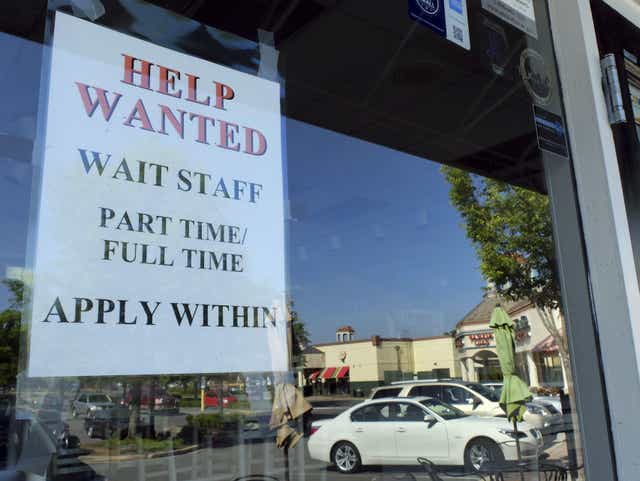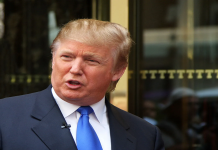The U.S. added 1.8 million jobs in July as payroll growth slowed amid a split-screen economy that had employers stepping up hiring in parts of the country that continued to let businesses reopen, even as COVID-19 spikes forced Sunbelt firms to pull back and lay off workers.
The unemployment rate fell to 10.2% from 11.1% in June, the Labor Department said Friday.
Economists surveyed by Bloomberg had estimated that 1.5 million jobs were added last month.
Starting in late June, nearly half the states paused or reversed reopenings because of surges in coronavirus cases, a rollback that particularly hit Texas, Arizona, Florida and California. Those losses were more than offset by net job gains elsewhere in the country as states relaxed restrictions.
Forecasting employment in July was a crap shoot, with some economists expecting upwards of two million gains and others anticipating losses.
The number of Americans on temporary layoff fell by 1.3 million to 9.2 million as more laid-off workers at restaurants, malls, gyms and other outlets were called back amid state reopenings. About 56% of unemployed workers said they were on temporary layoff, suggesting that many of the 16.3 million jobless workers could still be called back to work. .
Leisure and hospitality, the sector hit hardest by the pandemic, gained 592,000 jobs in June, mostly in restaurants and bars. Retail added 258,000; professional and business services, 170,000; and health care, 126,000.
Government added 301,000 jobs as payrolls were artificially inflated by 215,000 gains in local education. Since many school staffers were furloughed in April because of the pandemic, there were far fewer job reductions than normal in July, an anomaly that resulted in strong employment gains because of seasonal adjustments.
Besides the reopenings, job gains in the spring were juiced by forgivable federal loans to small businesses as long as they retained or rehired employees. Of the 22 million U.S. jobs shed in the early days of the pandemic, the economy recouped 2.7 million in May and 4.8 million in June, but after July’s additions payrolls are still at less than half their pre-pandemic level.
Clawing back the 13 million remaining lost jobs is likely to be a tougher slog as employers grapple with infection outbreaks and depleted cash. Many businesses have exhausted their federal loans, forcing some struggling firms to lay off workers a second time. Morgan Stanley foresees a “significant risk” of job losses in August.
“In the absence of additional fiscal aid, the broader economy risks losing momentum as it shifts into the second phase of its rehabilitation,” economist Kathy Bosjancic of Oxford Economics said in a research note.
Capital Economics is more sanguine, noting infections are starting to trend lower in hot-spot states.
“Employment should continue to rebound over the coming months,” the research firm wrote to clients.
Unemployed workers are coping with the expiration of a $600 federal supplement to state unemployment benefits. Congress is debating whether to renew both the small business loans and at least a portion of the jobless benefits as part of a new stimulus bill, but lawmakers have been deadlocked over the measure.
Barb Brown, 66, of Quartzsite, Arizona, was laid off from her job as a corporate travel agent in March. Her boss told her she’ll eventually be called back but with the crisis battering business travel more harshly than perhaps any other sector, she has no idea when.
She and her husband have been relying on her roughly $900 in unemployment benefits, along with small Social Security and disability payments, to pay their monthly bills and make repairs on their two motor homes, one of which they plan to sell. With the end of the $600 federal benefit, their jobless benefits have been slashed to about $300.
“Now things will really become tough,” she says. “It’s been very, very, very stressful.”
Charissa Ward, 37, was furloughed in April from her part-time server job at a restaurant at Disney’s Hollywood Studios in Orlando. She, her boyfriend and three children have stayed afloat, mostly on her $875 in weekly unemployment benefits, though it hasn’t replaced her wages. Ward, who worked 32 to 45 hours a week, has held the job for 15 years.
If she loses the $600 federal supplement, “It’ll be a struggle” to pay her mortgage, car insurance and other bills, she says.
She has applied for other jobs. But with local restaurants running at 50% capacity, “It’s not like anybody hiring,” she says.
While Ward, who has a psychology degree, has applied for social-work and other positions in her field, “So many people are out of work. It’s a big competition.”
The reinstatement of business constraints in states with COVID-19 surges has been captured in several recent measures of economic activity. The number of open small businesses at the end of July was roughly unchanged compared with the beginning of the month, according to Homebase, which makes scheduling software. And fewer employees were working slightly fewer hours.
A tracker of spending by Chase credit and debit card holders showed just a small increase in outlays between June and July, according to JPMorgan Chase.
Misclassification of workers continues
The unemployment rate continued to be skewed by some survey respondents who reported they were employed but absent from work even though they should have said they were on temporary layoff. If those workers had been classified properly, the unemployment rate would have been about a percentage point higher, at 11.2%, Labor said. But that’s a big improvement from May when the misclassification lowered unemployment by three percentage points.
Labor force participation dips
In June, the share of Americans working or looking for jobs – which together make up the labor force – dipped from 61.5% to 61.4%. That’s a slight negative because it means more people are on the sidelines, neither working nor job hunting. After sliding from 63.4% in February to a 47-year low of 60.2% in April, the rate had risen sharply the previous two months as an improving labor market drew in more Americans.
The July participation rate, which is still historically low, suggests that more people have lost jobs than the 10.2% unemployment rate implies, such as many baby boomers who decided to retire after being laid off.
Broader jobless measure drops
While the unemployment rate fell, a broader measure of joblessness also edged down. That gauge – which includes Americans working part-time even though they want full-time jobs, discouraged workers who have stopped looking and the unemployed – declined from 18% to 16.5%.












